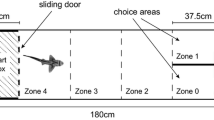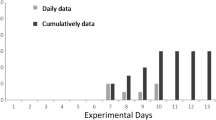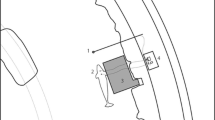Abstract
Walruses (Odobenus rosmarus) are highly vocal amphibious mammals with a range of anatomical specializations that can provide plasticity to their sound emissions. The objective of this descriptive study was to determine whether contingency learning could be used to increase variability and induce novelty in the acoustic behavior of walruses. The subjects were two twelve-year-old captive walruses, a male and a female that had previously been conditioned using food reinforcement to produce several specific sounds in response to different discriminative cues. In the current task, these individuals were encouraged to produce novel sounds and novel sound combinations in air by withholding reinforcement for sounds previously emitted in a given session and providing reinforcement only for qualitative differences in emitted sounds. Following training in air, the walruses were tested under water with the same reinforcement contingency. The subjects responded as they had done in air, by varying their underwater sound emissions until reinforcement was provided. Many of the sounds and sound combinations produced by the subjects during underwater testing were quite different from those produced during training in air and those produced under water during baseline observations. Both the male and female spontaneously emitted knocks and soft bells which are components of the songs known to be emitted by mature male walruses during the breeding season. The finding that reinforced variability can induce creativity in sound production is consistent with recent experiments on budgerigar birds showing that vocal topographies, like motor responses, may be influenced by contingency learning.


Similar content being viewed by others
References
Epstein R (1987) The spontaneous interconnection of four repertoires of behavior in a pigeon (Columbia livia). J Comp Psychol 101:197–201
Fay FH (1960) Structure and function of the pharyngeal pouches of the walrus (Odobenus rosmarus L.). Mammalia 24:361–371
Fay FH, Ray GC, Kibal’chich AA (1981) Time and location of mating and associated behavior of the Pacific walrus, Odobenus rosmarus divergens Illiger. In: Fay FH, Fedoseev GA (eds) Soviet-American Cooperative Studies of Marine Mammals, Volume 1—Pinnipeds. NOAA, National Marine Fisheries Service Technical Report, p. 89–99
Fay FH (1982) Ecology and biology of the Pacific walrus, Odobenus rosmarus divergens Illiger. North American Fauna, No. 74. US Dept of the Interior, Fish and Wildlife Service, Washington, DC
Gisiner R, Schusterman RJ (1992) Sequence, syntax, and semantics: responses of a language trained sea lion (Zalophus californianus) to novel sign combinations. J Comp Psychol 106:78–91
Grunow A, Neuringer A (2002) Learning to vary and varying to learn. Psychon Bull Rev 9:250–258
Herman LM, Richards DG, Wolz JP (1984) Comprehension of sentences by bottlenosed dolphins. Cognition 16:129–219
Manabe K, Staddon JER, Cleaveland JM (1997) Control of vocal repertoire by reward in budgerigars. J Comp Psychol 111:50–62
Marler P, Nelson DA (1993) Action-based learning: a new form of developmental plasticity in bird song. Neth J of Zool 43:91–103
Miller EH (1985) Airborne acoustic communication in the walrus Odobenus rosmarus. Natl Geogr Rep 1:124–145
Neuringer A (2004) Reinforced variability in animals and people: implications for adaptive action. Am Psychol 59: 891–906
Pryor KW, Haag R, O’Reilly J (1969) The creative porpoise: training for novel behavior. J Exp Anal Behav 12:653–661
Ray GC, Watkins WA (1975) Social function of the underwater sounds in the walrus Odobenus rosmarus. Rapports et Procès-Verbaux des Réunions 169: 524–526
Reichmuth Kastak C, Schusterman RJ, Kastak D (2001) Equivalence classification in California sea lions using class-specific reinforcers. J Exp Anal Behav 76:131–158
Schevill WE, Watkins WA, Ray C (1966) Analysis of underwater Odobenus calls with remarks on the development and function of the pharyngeal pouches. Zoologica 51:103–111
Schusterman RJ, Kastak D (1993) A California sea lions (Zalophus californianus) is capable of forming equivalence relations. Psychol Rec 43:823–839
Schusterman RJ, Kastak D (1998) Functional equivalence in a California sea lion: relevance to social and communicative interactions. Anim Behav 55:1087–1055
Schusterman RJ, Krieger K (1984) California sea lions are capable of semantic comprehension. Psychol Rec 34:3–24
Schusterman RJ (2008) Vocal learning in mammals with special emphasis on pinnipeds. In: Oller DK, Griebel U (eds) The evolution of communicative creativity: from fixed signals to contextual variability. MIT Press, Cambridge(in press)
Shahan TA, Chase PN (2002) Novelty, stimulus control, and operant variability. Behav Anal 25:175–190
Sjare B, Stirling I (1981) I hear you knocking. Nat Hist 3:60–63
Sjare B, Stirling I, Spencer C (2003) Structural variation in the songs of Atlantic walruses breeding in the Canadian high Arctic. Aquat Mamm 29:297–318
Skinner BF (1953) Science and human behavior. Macmillan, New York
Stirling I, Calvert W, Spencer C (1987) Evidence of stereotyped underwater vocalizations of male Atlantic walruses (Odobenus rosmarus rosmarus). Can J Zool 65:2311–2321
Tyack PL, Miller EH (2002) Vocal anatomy, acoustic communication and echolocation. In: Hoelzel (ed) Marine mammal biology: an evolutionary approach. Blackwell, Oxford, pp 142–184
Verboom WC, Kastelein RA (1995) Rutting whistles of a male Pacific walrus (Odobenus romarus divergens). In: Kastelein RA, Thomas JA, Nachtigall PE (eds) Sensory systems of aquatic mammals, De Spil, Woerden, The Netherlands, pp 287–298
Acknowledgments
We gratefully acknowledge the management of Six Flags Marine World for providing us with access to their walruses; we are especially indebted to Debbie Quihuis for providing invaluable animal training, research assistance, and walrus expertise at the park. We thank the research team at the Pinniped Cognition and Sensory Systems Lab at Long Marine Laboratory for their encouragement with this work, especially Marla Holt for support with acoustic analyses, Jon Brininger for audio-video support, and Kristy Lindemann for assistance with data collection. Sue Negrini provided very helpful information and ideas that contributed to the design of this study. This work was supported in part by Office of Naval Research grant N00014-06-447505. The experiments described herein comply with the current laws of the United States.
Author information
Authors and Affiliations
Corresponding author
Electronic supplementary material
Below is the link to the electronic supplementary material.
10071_2007_120_MOESM1_ESM.wmv
S1A. The underwater sounds corresponding to the spectrograms shown in Figure 1 for the male walrus, Sivuqaq (WMV 287 kb)
10071_2007_120_MOESM2_ESM.wmv
S1B. The underwater sounds corresponding to the spectrograms shown in Figure 1 for the male walrus, Sivuqaq (WMV 233 kb)
10071_2007_120_MOESM4_ESM.wmv
S1D. The underwater sounds corresponding to the spectrograms shown in Figure 1 for the male walrus, Sivuqaq (WMV 139 kb)
10071_2007_120_MOESM5_ESM.wmv
S1E. The underwater sounds corresponding to the spectrograms shown in Figure 1 for the male walrus, Sivuqaq (WMV 256 kb)
10071_2007_120_MOESM6_ESM.wmv
S1F. The underwater sounds corresponding to the spectrograms shown in Figure 1 for the male walrus, Sivuqaq (WMV 361 kb)
S3. Video samples from an in-air training session with the male walrus Sivuqaq. Note the highly graded sound emissions, the rapid transitions from one sound type to another, and the variety of structures with which the sounds are produced (WMV 3660 kb)
S4. Video recording of the male walrus Sivuqaq during his first underwater testing session. Chugging sounds, moans, and knocks are audible (WMV 1930 kb)
Rights and permissions
About this article
Cite this article
Schusterman, R.J., Reichmuth, C. Novel sound production through contingency learning in the Pacific walrus (Odobenus rosmarus divergens). Anim Cogn 11, 319–327 (2008). https://doi.org/10.1007/s10071-007-0120-5
Received:
Revised:
Accepted:
Published:
Issue Date:
DOI: https://doi.org/10.1007/s10071-007-0120-5




